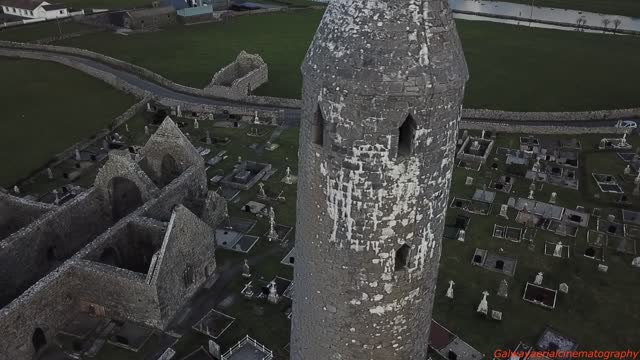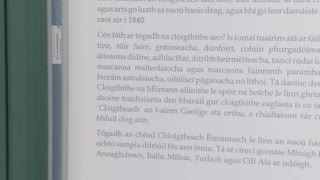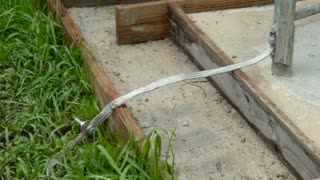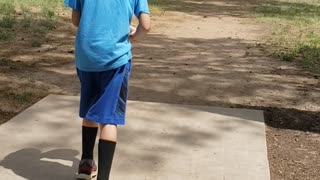Premium Only Content

The World’s Tallest Round Tower
Kilmacduagh Round Tower. Dating back to the 7th century this is one of Ireland’s oldest monastic sites.
The Round Tower has a clear lean and whilst many surrounding buildings are ruins,
Dimensions: There is an offset discernible on the west side of the tower, as the ground level slopes a bit on that side. Above this offset, the circumference is 17.86 meters, giving it an external diameter of 5.68 meters. The overall height of the tower is just about 34 meters, making it the tallest round tower in existence. The doorway, facing ENE is also extraordinary in that it is over 7 meters above ground level. This extreme height of the doorway causes some controversy in the usual assumption that an entry ladder would simply be pulled through the doorway into the tower in times of distress, as no rigid ladder of such length would fit through the tower doorway, nor would a rigid ladder fit inside the tower if it could be pulled inside. Kilmacduagh has the greatest number of windows of any existing round tower: 11. All are angle headed. The five windows in the drum in ascending order face N, SSE, W, E and WSW. When the building was repaired in 1878-79, three windows were restored to the original three. These six windows face NE ENE, ESE, SW, WSW, and WNW.
Features: The extreme height of the doorway, the number of bell-storey windows, and the significant lean to the SW all make this a quite unique tower. The cap on the drum is unusual in that it sits not atop a cornice, but overhangs the drum.
Comments: The walls are over six feet thick at the base, underneath which lie some skeletons, confirming that the tower had been built in an existing cemetery. The tower once had a bell which was said to have been thrown into a nearby lake. Tradition has it that backache can be cured by laying on St. Colman's grave (it lies behind the cathedral). Key's to the Grebe House and other locks can be obtained at the Tower View B & B (across the street) with a deposit of 5 Euro.
History:The 7th century saint, Saint Colman, son of Duagh, established a monastery on land given him by his cousin King Guaire. According to legend, Saint Colman MacDuagh was walking through the woods of the Burren when his girdle fell to the ground. Taking this as a sign, he built his monastery on this spot. The girdle was said to be studded with gems and was held by the O'Shaughnessys centuries later, along with St. Colman's crozier, or staff. The girdle was later lost, but the crozier came to be held by the O'Heynes and may now be seen in the National Museum of Ireland. The Catholic encyclopedia says of St. Colman: "Bishop and patron of Kilmacduagh, born at Kiltartan c. 560; died 29 October, 632. He lived for many years as a hermit in Arranmore, where he built two churches, both forming the present group of ruins at Kilmurvy. Thence he sought greater seclusion in the woods of Burren, in 592, and at length, in 610, founded a monastery, which became the centre of the tribal Diocese of Aidhne."
Other Items of Interest: This site was of such importance that it became the center of a new diocese in the 12th century. It is now merged with the Diocese of Galway. The monastery was plundered several times in the 13th century. The interesting carved stone features scattered throughout the small churches are worth searching for. These are mostly inserts from the late 11th to the 15th centuries.
-
 0:30
0:30
Beansy1966
4 years agoThe Round tower and Deanery cottages .
10 -
 0:14
0:14
klag33
4 years ago $0.01 earnedI Go Round and Round
137 -
 0:30
0:30
MisterLusitano
4 years ago $0.03 earnedRound and Round
156 -
 0:27
0:27
PeaceWorks
4 years agoBrothers round 2
60 -
 0:31
0:31
PeaceWorks
4 years agoBrothers round 1
1331 -
 2:52
2:52
Our Videos
4 years ago $0.01 earnedTower Installation
152 -
 0:09
0:09
SeekingTheNextAdventure
4 years ago $3.97 earnedTrump Tower
7.76K3 -
 0:21
0:21
TheRandon
4 years agoFlagstaff Round
36 -
 0:20
0:20
danieldoran425
4 years ago $0.01 earnedHollywood Tower
2181 -
 0:31
0:31
The blank
4 years ago $0.18 earnedRound an round
389